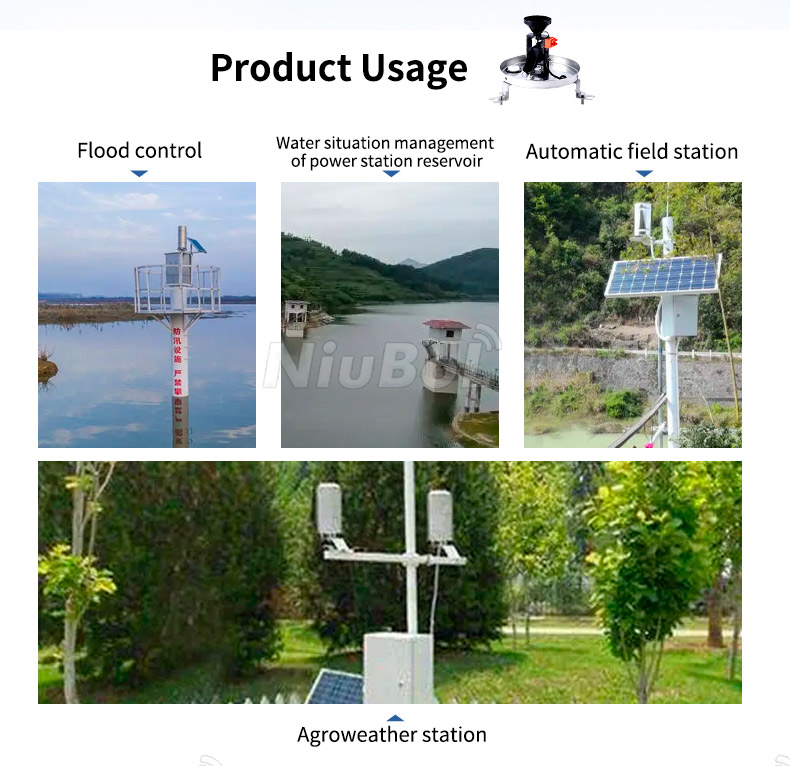

— Blogs —
—Products—
 Consumer hotline +8618073152920
Consumer hotline +8618073152920 WhatsApp:+8615367865107
Address:Room 102, District D, Houhu Industrial Park, Yuelu District, Changsha City, Hunan Province, China
Product knowledge
Time:2024-04-24 10:27:22 Popularity:1243
The tipping bucket rain gauge is a widely used rainfall measuring instrument, and its working principle is based on the movement mechanism of the tipping bucket. When rain falls on the tipping bucket, the bucket will turn over at a certain angle, and at the same time, the time and amount of each rainfall will be recorded.
The tipping bucket rain gauge can be widely used in meteorology, agriculture, water conservancy, environmental protection, land, railway and highway industries, such as meteorological stations, hydrological stations, flash flood early warning, geological monitoring and other real-time rainfall monitoring scenarios. Through wired or wireless way to send rainfall data to the nearby rainfall alarm or cloud server, to provide data support for industry users to command decision-making, and enhance the hydrological monitoring capacity.
There are some key differences between RS485 type tipping bucket rain gauge and pulse type tipping bucket rain gauge in function and structure as follows:
Data transmission mode:
RS485 type tipping bucket rain gauge adopts RS485 interface for data communication.RS485 is a serial communication protocol which is suitable for multi-point communication and long-distance transmission, and it can ensure stable communication between the rain gauge and the data acquisition system or other devices.
Pulse type tipping bucket rain gauge, on the other hand, records precipitation by generating a pulse signal through the tipping of the bucket. Each time the bucket is turned over, a pulse signal is output, and by counting these pulses, the amount of precipitation can be calculated.
Measurement accuracy and stability:
The two may differ in measurement accuracy and stability, depending on their respective design and manufacturing processes. However, in general, both can provide fairly accurate rainfall measurements as long as they are properly designed and manufactured.
Scenarios where tipping bucket rain gauges are applicable:
RS485 type tipping bucket rain gauge has the advantages of long transmission distance, high rate and strong anti-interference ability because it adopts RS485 interface for data communication. Therefore, it is especially suitable for occasions requiring remote monitoring and data transmission, such as meteorological stations, hydrological stations and so on. In these occasions, RS485 type tipping bucket rain gauge can be connected with other equipment or systems to achieve automatic data collection, transmission and processing, which is convenient for real-time monitoring and analysis of rainfall.
Pulse type tipping bucket rain gauge focuses more on local rainfall measurement. It records rainfall by generating pulse signals through the flip of the bucket, and can be directly connected with counters or data collectors to achieve real-time recording and display of rainfall. This type of rain gauge is suitable for some occasions where fast response and local data processing are required, such as field microclimate monitoring stations, reservoirs and so on. In these occasions, pulse type tipping bucket rain gauge can accurately record rainfall and provide timely data support for decision makers.
In general, RS485 type tipping bucket rain gauge is more suitable for large-scale occasions that require remote monitoring and data transmission, while pulse type tipping bucket rain gauge is more suitable for rapid measurement and recording of local rainfall. In practice, you can choose the right type of rain gauge according to your specific needs and usage scenarios.
System complexity and cost:
RS485 type tipping bucket rain gauge and pulse type tipping bucket rain gauge may have a certain difference in price, but the specific price difference will be affected by a variety of factors, such as brand, specifications, quality, market supply and demand.
RS485 type tipping bucket rain gauge may be relatively complex and costly due to the data communication and interface technology involved.
Pulse type tipping bucket rain gauge, on the other hand, is relatively simple and may cost less. However, the price difference between the 2 types of rain gauges is likely to narrow as market competition intensifies and technology advances.

Overall, tipping bucket rain gauge is a kind of intelligent equipment with high precision, automation, easy installation and durability, which has a wide range of application prospects in meteorological monitoring, water management, agricultural planning, environmental monitoring and other fields. When choosing a rain gauge, it is also necessary to comprehensively consider its measurement accuracy, stability, durability, applicable scenarios and after-sales service and other factors to ensure that the chosen rain gauge can meet the actual needs.
Related recommendations
Sensors & Weather Stations Catalog
Agriculture Sensors and Weather Stations Catalog-NiuBoL.pdf
Weather Stations Catalog-NiuBoL.pdf
Related products
 Combined air temperature and relative humidity sensor
Combined air temperature and relative humidity sensor Soil Moisture Temperature sensor for irrigation
Soil Moisture Temperature sensor for irrigation Soil pH sensor RS485 soil Testing instrument soil ph meter for agriculture
Soil pH sensor RS485 soil Testing instrument soil ph meter for agriculture Wind Speed sensor Output Modbus/RS485/Analog/0-5V/4-20mA
Wind Speed sensor Output Modbus/RS485/Analog/0-5V/4-20mA Tipping bucket rain gauge for weather monitoring auto rainfall sensor RS485/Outdoor/stainless steel
Tipping bucket rain gauge for weather monitoring auto rainfall sensor RS485/Outdoor/stainless steel Pyranometer Solar Radiation Sensor 4-20mA/RS485
Pyranometer Solar Radiation Sensor 4-20mA/RS485
Screenshot, WhatsApp to identify the QR code
WhatsApp number:+8615367865107
(Click on WhatsApp to copy and add friends)
